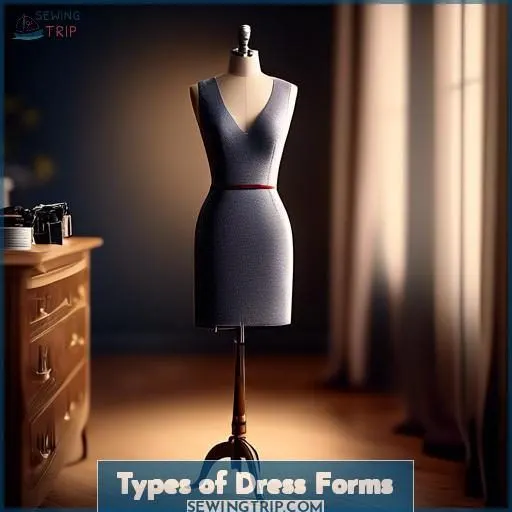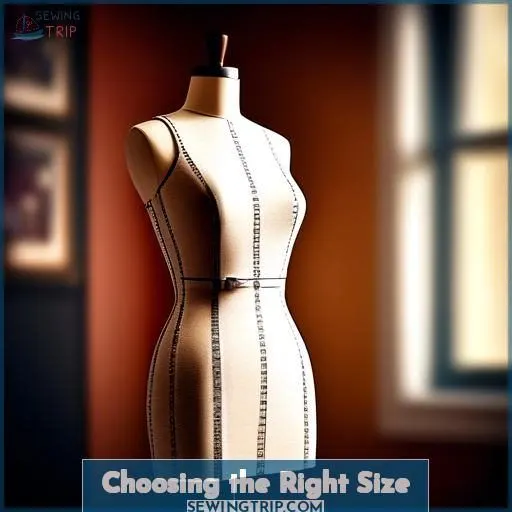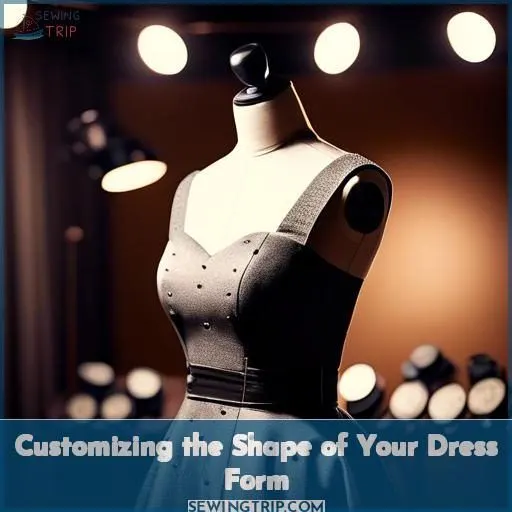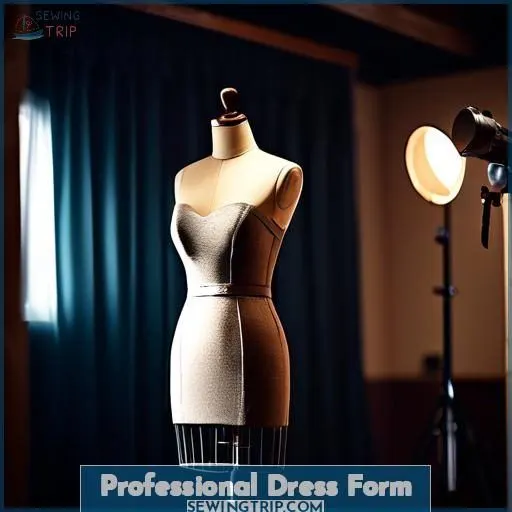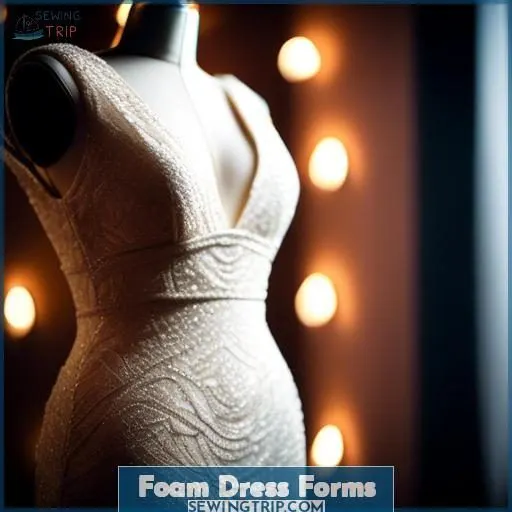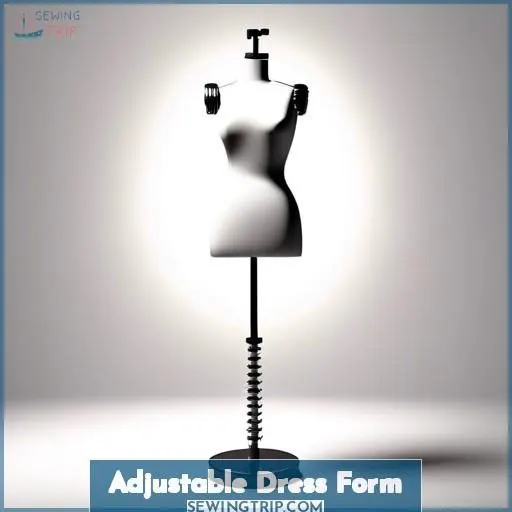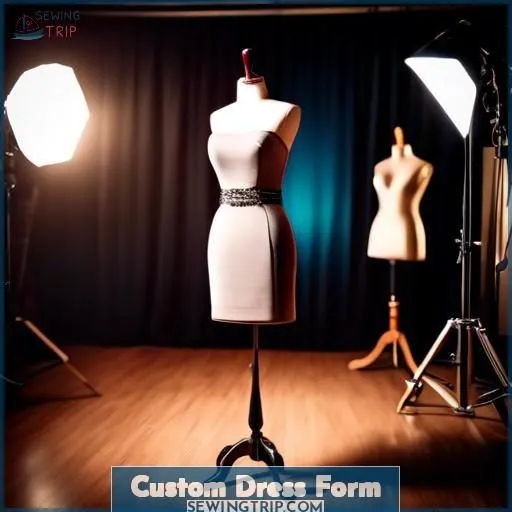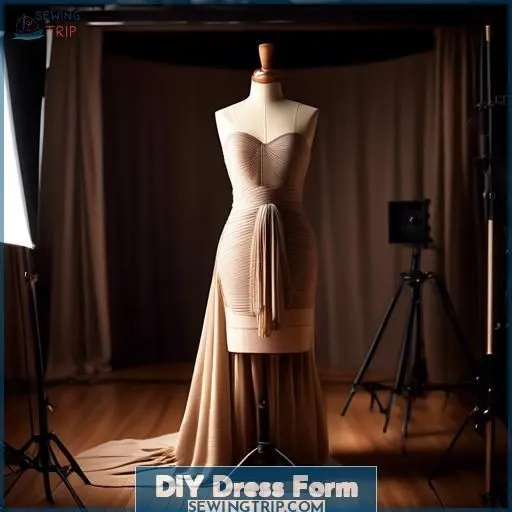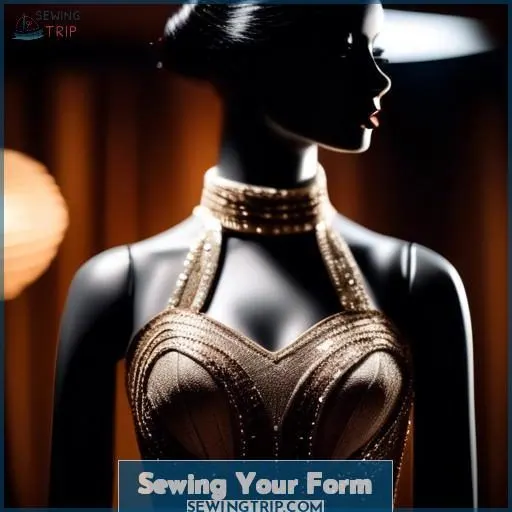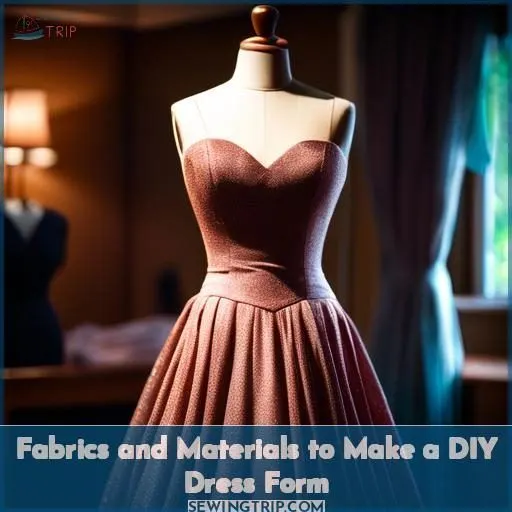This site is supported by our readers. We may earn a commission, at no cost to you, if you purchase through links.
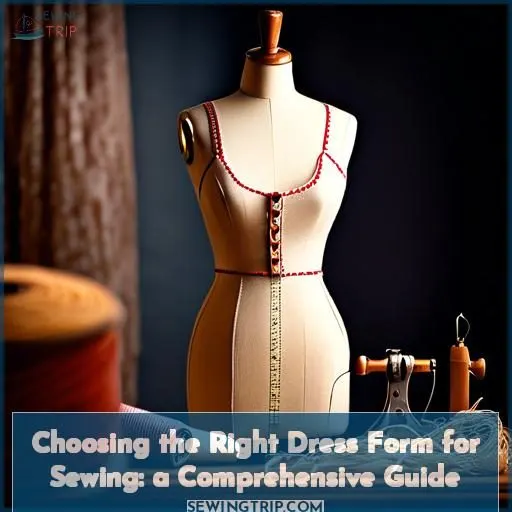
When buying a dress form for sewing, consider your needs. Select an adjustable form to accommodate multiple body types and projects. Professional forms offer premium quality and durability for serious sewers.
Foam forms are economical for display, while custom forms replicate your unique shape. Measure yourself carefully to choose the right size. Adjustable forms allow you to fine-tune the fit, while custom forms provide a perfect match.
Dress forms come in a range of materials, sizes, and features – understanding the options will help you find the perfect one to support your sewing goals.
Table Of Contents
- Key Takeaways
- How to Buy a Dress Form for Sewing?
- Types of Dress Forms
- Choosing the Right Size
- Customizing the Shape of Your Dress Form
- Professional Dress Form
- Foam Dress Forms
- Adjustable Dress Form
- Custom Dress Form
- DIY Dress Form
- Sewing Your Form
- Fabrics and Materials to Make a DIY Dress Form
- Frequently Asked Questions (FAQs)
- Conclusion
Key Takeaways
- Consider your needs when buying a dress form, such as adjustability, professional quality, economy, or customization.
- Measure yourself carefully to choose the right size and adjust the form accordingly.
- Understand the options available, including adjustable, professional, foam, custom, and DIY forms.
- Evaluate the size, durability, padding, and customization possibilities when selecting a dress form.
How to Buy a Dress Form for Sewing?
To buy a dress form for sewing, consider the following steps:
- Determine your needs: Consider what you’ll be using the dress form for, such as fitting, draping, or display purposes. This will help you choose the right type of dress form.
- Choose a type: There are several types of dress forms, including professional forms with cast iron bases, display forms, adjustable forms, and handmade forms. Professional forms are often made with papier mache and covered in linen, while adjustable forms have dials to adjust the size. Handmade forms can be made from a variety of materials, such as foam or fiberglass.
- Consider your budget: Dress forms range in price from budget-friendly options to more expensive custom forms. If you’re on a tight budget, consider DIY options like making a dress form from duct tape or paper mâché.
- Look for adjustability: If you need a dress form for fitting purposes, look for one that can be adjusted to your measurements. Many adjustable forms have dials that allow you to expand and contract the form as needed.
- Check for quality: Make sure the dress form is sturdy and has a base that’s easy to move and adjust. Look for features like collapsible shoulders, pinnable surfaces, and standard markings for draping and fitting.
- Shop around: Compare prices and features from different brands and retailers to find the best dress form for your needs and budget. Consider buying a used form from sources like Craigslist or local sewing groups to save money.
- Read reviews: Look for reviews from other sewists to get an idea of the quality and performance of different dress forms. Sewing forums and blogs can be a good source of information and advice.
Types of Dress Forms
Regarding the selection of an appropriate dress form for your sewing endeavors, there are numerous varieties to contemplate. Dress forms can be classified based on their adaptability, longevity, and the components from which they’re fabricated. Here are some of the most prevalent types:
- Adjustable Dress Forms: These forms facilitate modifications to the dimensions and contours, rendering them appropriate for a multitude of projects and body types. They frequently incorporate dials or other contraptions to adjust the form to varying measurements.
- Professional Dress Forms: These premium forms are engineered for professional utilization in the fashion industry. They’re typically crafted from high-density materials and possess sturdy bases, making them ideal for draping and fitting garments.
- Foam Dress Forms: These forms are composed of foam and are often more economical than other types. They may possess simplified body shapes and are suitable for display purposes, but they may not be as durable or adjustable as other types.
- Custom Dress Forms: These forms are created from a 3D scan of an individual’s body, providing an accurate portrayal of their shape and size. They’re often utilized by professional tailors and costume designers for precise fitting and tailoring.
- DIY Dress Forms: These forms can be fabricated using diverse materials such as duct tape, paper mâché, or foam. They’re a budget-friendly option for those desiring a form that closely resembles their body shape.
When selecting a dress form, contemplate your intended utilization, budget, body measurements, and desired attributes. Adjustable forms can be an ideal choice for those who need to accommodate varying sizes or for those who desire a form that can be adjusted for diverse projects. Professional forms are perfect for draping and fitting garments, while foam forms are more affordable and suitable for display purposes. Custom forms provide the most accurate representation of an individual’s body shape, and DIY forms can be a fun and budget-friendly option.
Choosing the Right Size
When selecting a dress form, the size you choose is critical. Select a form that closely corresponds to your body measurements to guarantee a precise fit for your garments.
Size Selection
When selecting a dress form, it’s vital to take into account your body dimensions and the available size alteration possibilities. If your physique varies or you intend to create clothing for others, an adjustable dress form might be a wiser option. These forms are hollow with a pliable covering and can be adjusted using dials to alter the bust, waist, and hip measurements. However, they may create gaps at seams when adjusted and aren’t ideal for draping or intricate pattern making.
For plus size dress forms, it’s key to find a form with the same proportions as your body, as measurements alone are inadequate. You may need to consider a form with adjustable attributes or one that can be customized to match your body shape.
If you’re seeking a professional dress form, contemplate the size and shape that best aligns with your body. You can choose a fixed size nearest to your body measurements or opt for an adjustable form if your size fluctuates. Remember that professional forms are more durable and suited for draping, fitting, and pattern making.
When selecting a dress form, take into account your budget and the intended purpose. Display forms are more economical but may not offer the same degree of customization as professional forms. Custom dress forms can be made to your exact measurements using duct tape or other materials, but they can be more time-consuming and costly.
Adjustability
Adjustability is a vital aspect when selecting a dress form. Dress forms come in diverse sizes, and choosing the correct one is essential for precise fitting and sewing. Here are some points to evaluate:
- Size selection: Most dress forms come in fixed sizes, so select a size closest to your body measurements. If your body size fluctuates, consider a smaller size or an adjustable form.
- Durability: Professional forms are more durable than adjustable forms, which may wear out over time. Consider the form’s durability based on your intended usage.
- Form padding: Custom forms can be padded to replicate your body shape more accurately. This can be done using padding kits or DIY methods.
- 3D scanning: Custom forms can be made from a 3D scan of your body, providing a perfect fit. This process involves taking measurements and creating a digital model of your body shape.
- Custom features: Custom forms can include collapsible shoulders, bifurcated legs, and other features modified to your needs.
- Collapsible shoulders: These are useful for fitting garments with closures, as they allow you to relax the garment over the form.
- Hat rack: Some dress forms have a built-in hat rack for storing hats or other accessories.
When choosing a dress form, evaluate your intended usage, budget, body measurements, and desired features. Adjustability, durability, and form padding are all significant factors to consider.
Durability
Concerning durability, a professional dress form stands out as an optimal choice. Constructed with premium materials and robust bases, these forms are designed for extended service. Here are five essential attributes that enhance their longevity:
- Foam Core: The core of a professional dress form frequently consists of a dense foam material, offering stability and support.
- Metal Base: A metal base provides additional weight and stability, guaranteeing the form’s upright position during use.
- Sturdy Construction: Professional dress forms are engineered to endure the demands of everyday use, encompassing pinning, draping, and muslin drafting.
- Enduring: With appropriate care and maintenance, a professional dress form can endure for years, rendering it a valuable investment for sewing enthusiasts.
- Sewing and Fitting: The durability of a professional dress form is pivotal for activities such as sewing and fitting, as it enables precise measurements and adjustments over time.
Customizing the Shape of Your Dress Form
Modifying the form of your dress form is a vital step in securing an ideal fit for your garments. Dress forms can be modified to more accurately replicate your body’s structure, incorporating cushioning in the appropriate areas to accommodate curves and variations in form. Here are several methods to assist you in modifying your dress form:
- Adjusting to curves: Cushioning can be added to the bust, hips, and waist to better match your body shape. Utilize a combination of quilted muslin and secondhand shoulder pads for a natural appearance.
- Shape replication: If your dress form is small enough, you can reshape the back and waistline to better match your body’s shape.
- Customization techniques: Employ foam, duct tape, or other materials to create a personalized dress form that closely resembles your body shape. For instance, you can use expanding foam to fill a duct tape form, but be aware that the foam may expand and not solidify properly, resulting in an inaccurate representation.
- Foam: Foam can be used to create a homemade dress form, but keep in mind that it may not accurately represent your body shape due to its asymmetrical pressure, causing the form to appear thinner from the front and back but thicker from the sides.
- DIY dress form: You can create a duct tape dress form by wrapping yourself in duct tape, cutting it open, and filling it with foam. This method requires patience and precision, as it can be time-consuming and may not yield a perfect representation of your body shape.
Professional Dress Form
When you’re ready to elevate your sewing to the next level, a professional dress form is your trusty sidekick. Imagine a body double that never complains, with a pinnable exterior that anticipates your latest creation. Here’s what to look for:
- Collapsible shoulders for slipping on form-fitting masterpieces with ease.
- Adjustable height to match your eye level, making pattern fitting a breeze.
- Durable construction that stands the test of time, unlike a flimsy display dress form.
Master the art of draping with a form that’s got your back!
Foam Dress Forms
Foam dress forms are an affordable alternative to professional dress forms. They can be used for pinning techniques, but their squishy bodies may not provide the same level of support as a professional form.
When choosing fabric for your project, consider the type of foam used in the form. Some foam dress forms may require specific care and maintenance, such as storing them in a cool, dry place to prevent warping.
If you’re looking for an alternative material, consider using PVC pipe to create a custom form. Remember, foam dress forms aren’t as durable as professional forms, so they may not be suitable for long-term use or frequent adjustments.
Adjustable Dress Form
Regarding the selection of an appropriate dress form for sewing purposes, adjustable dress forms present a flexible and accessible alternative. These forms feature a hollow interior covered in soft felt or fabric, enabling adjustments to measurements for bust, waist, hip, neck, and center back via dials. Specific models may additionally allow for alterations in neck circumference and body length. Adjustable dress forms serve as a suitable starting point for individuals new to utilizing a form and are also ideal for those who create garments for others or experience fluctuations in size.
One of the primary merits of adjustable dress forms lies in their accessibility. They’re widely available and can constitute a cost-efficient option for those hesitant to invest in a more expensive, fixed-size professional form. Adjustable dress forms also offer convenience for individuals who must accommodate a variety of sizes or desire to modify their form as their body shape evolves.
However, adjustable dress forms do have certain limitations. As they expand, they create gaps in the form, which can render them less suitable for draping or intricate pattern making, as they lack a completely flat, solid surface for work. Furthermore, adjustable dress forms may not possess the same sturdiness as professional forms, potentially impacting their durability.
When contemplating an adjustable dress form, it’s crucial to evaluate the benefits against the potential drawbacks. If you seek a form that can adapt to your changing body shape or accommodate a range of sizes, an adjustable dress form could be a viable option. However, if you’re dedicated to draping garments or require a more robust form for pinning and draping, a professional dress form may prove to be a wiser investment.
Custom Dress Form
If you’re looking for a dress form that perfectly matches your unique body shape, consider a custom dress form. This type of form is created using a body scan or 3D model of your body, ensuring a perfect fit. It’s ideal for those who want a high-quality, professional-grade form that caters to their specific needs.
While it may be more expensive than other options, it’s a budget-friendly choice compared to custom-made professional forms.
If you’re on a tight budget, you can opt for a DIY dress form, but keep in mind that it may not offer the same level of accuracy and detail as a custom form.
DIY Dress Form
If you’re looking for a budget-friendly and customizable dress form, a DIY dress form is an excellent option. Here’s a step-by-step guide on how to create your own:
- Choose Your Fabric: Select a medium-weight, non-stretch woven fabric for your dress form. Fabrics like linen, cotton twill, canvas, quilting fabric, and even muslin can work well. Avoid using heavy or lightweight fabrics that may not be suitable for the project.
- Select Your Pattern: Choose a customizable dress form pattern, such as the Bootstrap Fashion Dress Form pattern, which includes a PDF pattern with 18 pattern pieces and a 44-page instruction booklet.
- Gather Your Materials: In addition to the fabric, you’ll need a woven fusible interfacing for reinforcement, a rigid and heavy-weight fabric for the inner support, and any padding materials you may need for customization.
- Follow the Instructions: Carefully follow the pattern instructions to create your dress form. This may involve cutting out the pattern pieces, taping them together, and assembling the form using a tight straight stitch. Be sure to press seams open and clip where there are curves.
Sewing Your Form
Sewing your form can be a rewarding experience that allows you to create a dress form that closely resembles your body shape. Start by selecting the right sewing materials, such as quilted muslin or foam, and consider padding options to adjust the form’s shape. Remember to account for budget considerations and the time commitment involved in constructing your form. For a more detailed guide, refer to the table below.
| Step | Description |
|---|---|
| 1 | Choose sewing materials (quilted muslin, foam) |
| 2 | Select padding options (shoulder pads, quilted muslin) |
| 3 | Consider body shape adjustments |
| 4 | Account for budget and time commitment |
| 5 | Follow a sewing tutorial or pattern |
| 6 | Adjust form as needed |
| 7 | Test fit the form |
| 8 | Make any necessary adjustments |
Fabrics and Materials to Make a DIY Dress Form
Regarding the creation of a DIY dress form, multiple approaches exist, each utilizing distinct materials and techniques. Below is a summary of the commonly employed methods:
- Duct Tape Approach: This expedient and straightforward method employs duct tape to fashion a dress form. A cooperative model, a form-fitting t-shirt or refuse bag, and a duct tape roll are required. Encase the model in the t-shirt or bag, then apply successive layers of duct tape to form the shape. Upon drying, detach the form from the model and modify its contours as desired.
- Paper Mache Approach: This method entails the usage of plaster of Paris, paper pulp insulation, wallpaper adhesive, a capacious mixing bowl, plastic/saran wrap, paper towels, a hair dryer, colorless glue, knitted fabric, and a refuse bag or form-fitting t-shirt. Encase the model’s torso in plastic/saran wrap, then apply layers of paper mache. Once dry, detach the form from the model and cover it with knitted fabric to facilitate pinning and draping.
- Foam Approach: This method utilizes foam insulation, such as cellulose insulation or expanding foam. Encase the model in a swimsuit or form-fitting t-shirt, then fill it with foam. Apply layers of paper mache or paper tape to form the shape. Upon drying, detach the form from the model and modify its contours as desired.
- Padding Kits: These are prefabricated kits that contain diverse padding options to personalize the shape of your dress form. They can be utilized in conjunction with any of the aforementioned methods to enhance or modify specific features.
- 3D Scanning Approach: For a more precise and professional-grade dress form, consider obtaining a 3D scan of your body. This will produce a highly detailed and accurate form that captures all your unique curves and features. These forms are typically constructed from closed-cell foam material, which possesses flexibility, durability, and resilience.
Frequently Asked Questions (FAQs)
How often should I clean my dress form?
Ah, cleaning your dress form? A ritual as sacred as the garments it holds! Treat it like your favorite pet – a weekly brushing keeps that baby looking runway-ready. Anything less is fashion blasphemy, my friend.
Can I use my dress form for display purposes?
Your dress form can double as a stylish display piece. Just drape fabrics, accessories, or finished garments on it to showcase your creations. It’s an easy way to add flair to any sewing space.
How do I store my dress form when not in use?
When your dress form’s not in use, tuck it away with care – nestle it in a cozy corner, cover it up snug as a bug. That way, it’ll be raring to go when sewing’s on the menu, good as new!
Can I make adjustments to my dress form after purchase?
Most dress forms allow for adjustments to customize the fit. Dial in the bust, waist, and hips to match your body. Some even have collapsible shoulders for easy garment placement. Play around until it’s a perfect fit.
Are there any dress forms specifically designed for children?
Yes, you can find children’s dress forms designed just for them. Look for adjustable kids’ dress forms that let you customize the size as they grow. These miniature models make fitting and sewing children’s clothing a breeze.
Conclusion
Ultimately, choosing the right dress form for sewing can make all the difference in your projects. Consider Sarah, an avid sewist who struggled with fitting her handmade garments until she invested in an adjustable dress form that allowed her to precisely replicate her unique body shape.
Whether you opt for a professional, foam, or custom dress form, the key is finding the form that best supports your sewing goals and empowers you to create garments that fit flawlessly.
Don’t settle – find the perfect dress form to take your sewing to new heights.

